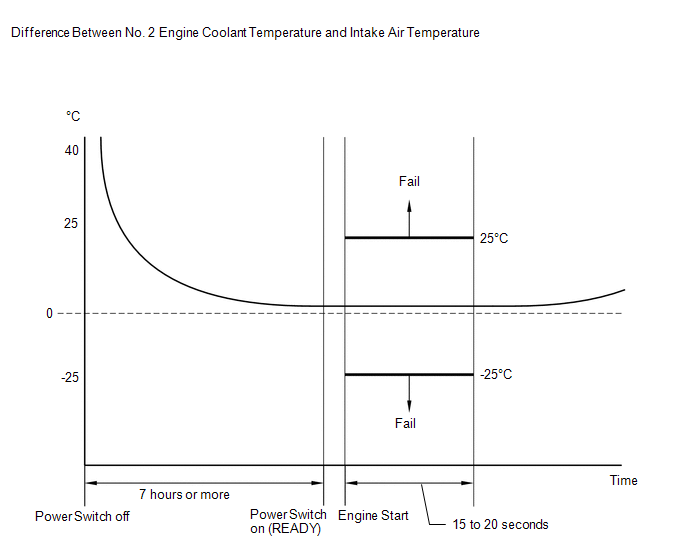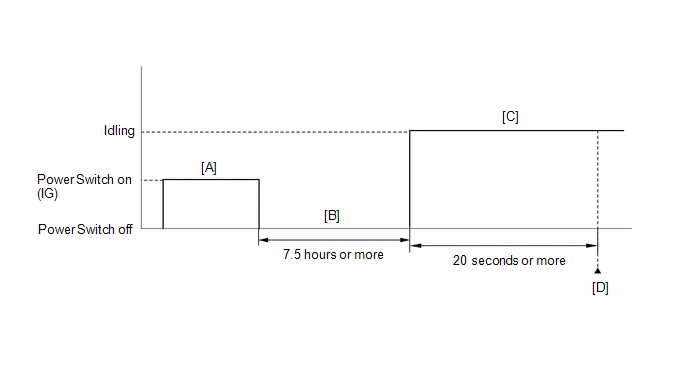Lexus ES: Radiator Coolant Temperature Sensor Signal Compare Failure (P00B162)
DESCRIPTION
This engine uses a No. 2 engine coolant temperature sensor and an intake air temperature sensor to detect temperatures related to engine operation. A thermistor, whose resistance value varies according to the temperature, is built into each sensor. When the temperature becomes low, the resistance of the thermistor increases. When the temperature becomes high, the resistance decreases. These variations in resistance are transmitted to the ECM as voltage changes.
| DTC No. | Detection Item | DTC Detection Condition | Trouble Area | MIL | Memory | Note |
|---|---|---|---|---|---|---|
| P00B162 | Radiator Coolant Temperature Sensor Signal Compare Failure | All of the following conditions are met (2 trip detection logic):
|
| Comes on | DTC stored | SAE Code: P00B2 |

MONITOR DESCRIPTION
The ECM monitors the difference between the No. 2 engine coolant temperature and the intake air temperature when the engine is started cold to accurately detect the engine temperature conditions. The monitor runs when the engine is started after 7 hours or more have elapsed since the power switch was turned off in the previous trip. If the difference between the engine coolant temperature and the intake air temperature on a cold start exceeds 25°C (45°F), the ECM interprets this as a malfunction in the No. 2 engine coolant temperature sensor circuit or intake air temperature sensor circuit, illuminates the MIL and stores this DTC.
MONITOR STRATEGY
| Related DTCs | P00B2: No. 2 engine coolant temperature sensor rationality |
| Required Sensors/Components (Main) | No. 2 engine coolant temperature sensor Intake air temperature sensor |
| Required Sensors/Components (Related) | - |
| Frequency of Operation | Once per driving cycle |
| Duration | 15 seconds |
| MIL Operation | 2 driving cycles |
| Sequence of Operation | None |
TYPICAL ENABLING CONDITIONS
| All of the following conditions are met | - |
| Soak time | 7 hours or more |
| Auxiliary battery voltage | 10.5 V or higher |
| Time after engine start | Less than 20 seconds |
| Intake air temperature at hybrid system ready-to-drive | -10°C (14°F) or higher |
| Intake air temperature sensor circuit fail (P0112, P0113) | Not detected |
| No. 2 engine coolant temperature sensor circuit fail (P00B3, P00B4) | Not detected |
| Soak timer fail (P2610) | Not detected |
TYPICAL MALFUNCTION THRESHOLDS
| Deviated No. 2 engine coolant temperature and intake air temperature | Less than -25°C (-45°F), or higher than 25°C (45°F) |
CONFIRMATION DRIVING PATTERN
HINT:
-
After repair has been completed, clear the DTC and then check that the vehicle has returned to normal by performing the following All Readiness check procedure.
Click here
.gif)
-
When clearing the permanent DTCs, refer to the "CLEAR PERMANENT DTC" procedure.
Click here
.gif)

- Connect the Techstream to the DLC3.
- Turn the power switch on (IG) [A].
- Turn the Techstream on.
- Clear the DTCs (even if no DTCs are stored, perform the clear DTC procedure).
- Turn the power switch off.
- With the engine stopped, leave the vehicle as is for 7.5 hours or more [B].
- Turn the power switch on (IG).
- Turn the Techstream on.
-
Put the engine in Inspection Mode (Maintenance Mode).
Click here
.gif)
- Start the engine and wait 20 seconds or more [C].
- Enter the following menus: Powertrain / Engine / Trouble Codes [D].
-
Read the pending DTCs.
HINT:
- If a pending DTC is output, the system is malfunctioning.
- If a pending DTC is not output, perform the following procedure.
- Enter the following menus: Powertrain / Engine / Utility / All Readiness.
- Input the DTC: P00B162.
-
Check the DTC judgment result.
Techstream Display
Description
NORMAL
- DTC judgment completed
- System normal
ABNORMAL
- DTC judgment completed
- System abnormal
INCOMPLETE
- DTC judgment not completed
- Perform driving pattern after confirming DTC enabling conditions
HINT:
- If the judgment result is NORMAL, the system is normal.
- If the judgment result is ABNORMAL, the system is malfunctioning.
- If the judgment result is INCOMPLETE, perform steps [B] through [D] again.
-
[B] to [D]: Normal judgment procedure.
The normal judgment procedure is used to complete DTC judgment and also used when clearing permanent DTCs.
- When clearing the permanent DTCs, do not disconnect the cable from the auxiliary battery terminal or attempt to clear the DTCs during this procedure, as doing so will clear the universal trip and normal judgment histories.
CAUTION / NOTICE / HINT
NOTICE:
-
Vehicle Control History may be stored in the hybrid vehicle control ECU assembly if the engine is malfunctioning. Certain vehicle condition information is recorded when Vehicle Control History is stored. Reading the vehicle conditions recorded in both the Freeze Frame Data and Vehicle Control History can be useful for troubleshooting.
Click here
.gif)
(Select Powertrain in Health Check and then check the time stamp data.)
Click here
.gif)
-
If any "Engine Malfunction" Vehicle Control History item has been stored in the hybrid vehicle control ECU assembly, make sure to clear it. However, as all Vehicle Control History items are cleared simultaneously, if any Vehicle Control History items other than "Engine Malfunction" are stored, make sure to perform any troubleshooting for them before clearing Vehicle Control History.
Click here
.gif)
HINT:
Read Freeze Frame Data using the Techstream. The ECM records vehicle and driving condition information as Freeze Frame Data the moment a DTC is stored. When troubleshooting, Freeze Frame Data can help determine if the vehicle was moving or stationary, if the engine was warmed up or not, if the air fuel ratio was lean or rich, and other data from the time the malfunction occurred.
PROCEDURE
| 1. | CHECK ANY OTHER DTCS OUTPUT (IN ADDITION TO DTC P00B162) |
(a) Connect the Techstream to the DLC3.
(b) Turn the power switch on (IG).
(c) Turn the Techstream on.
(d) Enter the following menus: Powertrain / Engine / Trouble Codes.
(e) Read the DTCs and record the Freeze Frame Data.
Powertrain > Engine > Trouble Codes| Result | Proceed to |
|---|---|
| DTC P00B162 is output | A |
| DTC P00B162 and other DTCs are output | B |
HINT:
If any DTCs other than P00B162 are output, troubleshoot those DTCs first.
| B | .gif) | GO TO DTC CHART |
|
| 2. | CHECK FREEZE FRAME DATA (COOLANT TEMPERATURE AND RADIATOR COOLANT TEMPERATURE) |
(a) Connect the Techstream to the DLC3.
(b) Turn the power switch on (IG).
(c) Turn the Techstream on.
(d) Using the Techstream, read the values displayed in the freeze frame data recorded in step 1.
Powertrain > Engine > DTC(P00B162) > Freeze Frame Data| Tester Display |
|---|
| Coolant Temperature |
| Radiator Coolant Temperature |
(e) Read the value displayed on the Techstream.
Standard:
Difference between the Coolant Temperature and the Radiator Coolant Temperature is within 15°C (27°F).
HINT:
When the engine is cold, the value of the intake air temperature, ECM internal temperature and ambient temperature should be approximately the same.
| NG | .gif) | REPLACE NO. 2 ENGINE COOLANT TEMPERATURE SENSOR |
|
| 3. | CHECK FREEZE FRAME DATA (COOLANT TEMPERATURE AND INTAKE AIR TEMPERATURE) |
(a) Connect the Techstream to the DLC3.
(b) Turn the power switch on (IG).
(c) Turn the Techstream on.
(d) Using the Techstream, read the values displayed in the Freeze Frame Data recorded in step 1.
Powertrain > Engine > DTC(P00B162) > Freeze Frame Data| Tester Display |
|---|
| Coolant Temperature |
| Intake Air Temperature |
(e) Read the value displayed on the Techstream.
Standard:
Difference between the Coolant Temperature and the Intake Air Temperature is within 15°C (27°F).
HINT:
- When the engine is cold, the value of the intake air temperature, ECM internal temperature and ambient temperature should be approximately the same.
-
Perform "Inspection After Repair" after replacing the engine coolant temperature sensor.
Click here
.gif)
.gif)
| OK | .gif) | REPLACE ECM |
| NG | .gif) | REPLACE ENGINE COOLANT TEMPERATURE SENSOR |

.gif)
